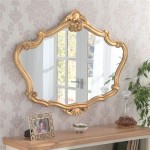Which Type of Mirrors Are Used in Vehicles?
Vehicle mirrors are critical for driver safety, providing a view of the surrounding environment and mitigating blind spots. Different types of mirrors serve distinct purposes, each designed with specific curvatures and reflective properties to optimize visibility. Understanding the types of mirrors used in vehicles and their functionalities is crucial for safe and effective driving.
Plane Mirrors:
Plane mirrors possess a flat reflective surface. These mirrors produce a virtual image that is the same size and distance from the mirror as the object being reflected. While they offer a true representation of size and distance, their field of view is limited. Due to this limited view, plane mirrors are not typically used as primary viewing mirrors in vehicles. However, they can be found in some interior applications, such as rearview mirrors with a selectable plane/convex setting.Convex Mirrors:
Convex mirrors have a curved reflective surface that bulges outward. This curvature allows them to reflect a wider field of view than a plane mirror of the same size. The image produced by a convex mirror is virtual, upright, and smaller than the actual object. This wider field of view comes at the cost of image distortion and making objects appear farther away than they actually are. This distortion is why convex mirrors often carry the inscription "Objects in mirror are closer than they appear." Due to their wide viewing angle, convex mirrors are commonly used as passenger-side wing mirrors and sometimes as supplementary blind-spot mirrors.Concave Mirrors:
Concave mirrors feature a curved reflective surface that curves inward. These mirrors can produce both real and virtual images depending on the distance of the object from the mirror. When an object is close to a concave mirror, the image appears magnified and virtual. However, when the object is farther away, the image becomes real, inverted, and can be smaller or larger depending on the distance. Concave mirrors are not typically used as primary viewing mirrors in standard vehicles due to the potential for image inversion and the limited range within which they provide a useful upright image.Non-Reversing Mirrors:
While not a different type of mirror based on curvature, non-reversing mirrors deserve mention. These mirrors employ multiple reflections or prisms to produce an image that is not laterally inverted. In traditional mirrors, left appears right, and vice-versa. Non-reversing mirrors correct this, providing a more intuitive view, particularly when judging distances and the movement of other vehicles. While promising in their ability to improve depth perception, non-reversing mirrors haven’t achieved widespread adoption in standard vehicles due to the complexity and cost associated with their design.Aspherical Mirrors:
Aspherical mirrors represent a significant advancement in automotive mirror technology. These mirrors combine different curvatures within a single mirror surface. Typically, the outer portion of an aspherical mirror has a greater curvature (more convex) than the inner portion. This design expands the field of view while minimizing distortion at the center of the mirror. Aspherical mirrors are becoming increasingly common as driver-side wing mirrors, offering an enhanced view of the driver's blind spot compared to traditional convex mirrors.Materials and Construction:
Beyond the type of curvature, vehicle mirror construction also involves various materials and coatings. Glass is the primary reflective material, chosen for its clarity and durability. It's often treated with reflective coatings such as silver or aluminum to maximize reflectivity. Mirror glass may also be tinted or treated with anti-glare coatings to reduce glare from headlights at night. The housing and supporting structure of the mirror are typically made from durable plastics or metals, designed to withstand environmental conditions and impacts.Smart Mirrors:
Automotive mirror technology continues to evolve with the integration of advanced features. Smart mirrors often incorporate cameras and sensors. Blind Spot Monitoring systems use sensors and cameras in conjunction with the mirrors to detect vehicles in the driver's blind spots. Lane Change Assist features also utilize cameras and may project warnings onto the mirror surface. Some smart mirrors can automatically dim in response to bright headlights, further reducing glare and enhancing night visibility. Furthermore, integrated turn signals within the mirror housing are becoming increasingly common, improving visibility for surrounding drivers.Regulations and Standards:
The specifications for vehicle mirrors, including their size, curvature, and placement, are subject to strict regulations. These regulations vary by country and region, but generally aim to ensure adequate visibility and minimize blind spots. Regulations often dictate specific requirements for the field of view provided by different mirrors, ensuring standardized safety features across vehicles.Maintenance and Adjustments:
Regularly cleaning and adjusting vehicle mirrors is essential for maintaining optimal visibility. Dirt, grime, and even minor adjustments to the mirror angle can significantly impact the driver's ability to perceive the surroundings. Drivers should familiarize themselves with the adjustment mechanisms for their vehicle's mirrors and make necessary adjustments before each trip to ensure a clear and unobstructed view of the surrounding traffic.
Why The Side Mirrors Majorly Of All Heavy Vehicles Are Small In Size Quora

Convex Mirrors Use Car

Convex And Concave Mirrors In Cars

Side View Mirror Wikipedia

What Is A Convex Mirror And Where Do You Use It For Jeka

Identify The Type Of Mirror Used Here

What Type Of Mirror Is Used As Side In Vehicle And Why Brainly

Objects In Mirror Are Closer Than They Appear Wikipedia

How To Properly Use Your Car S Side Mirrors

Mirrors For Security And Safety Complete Guide Insight








